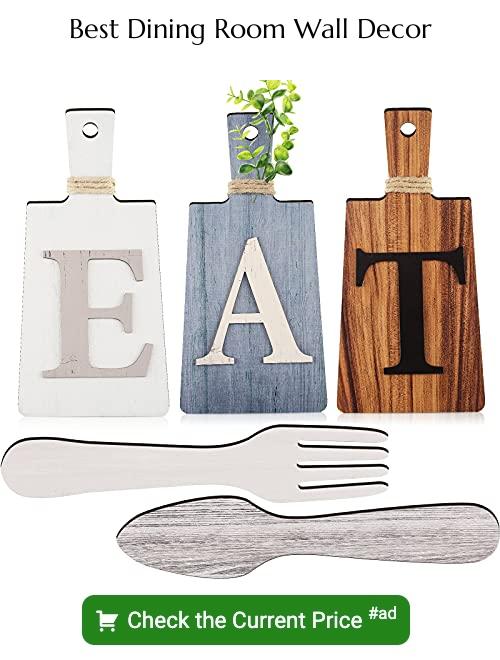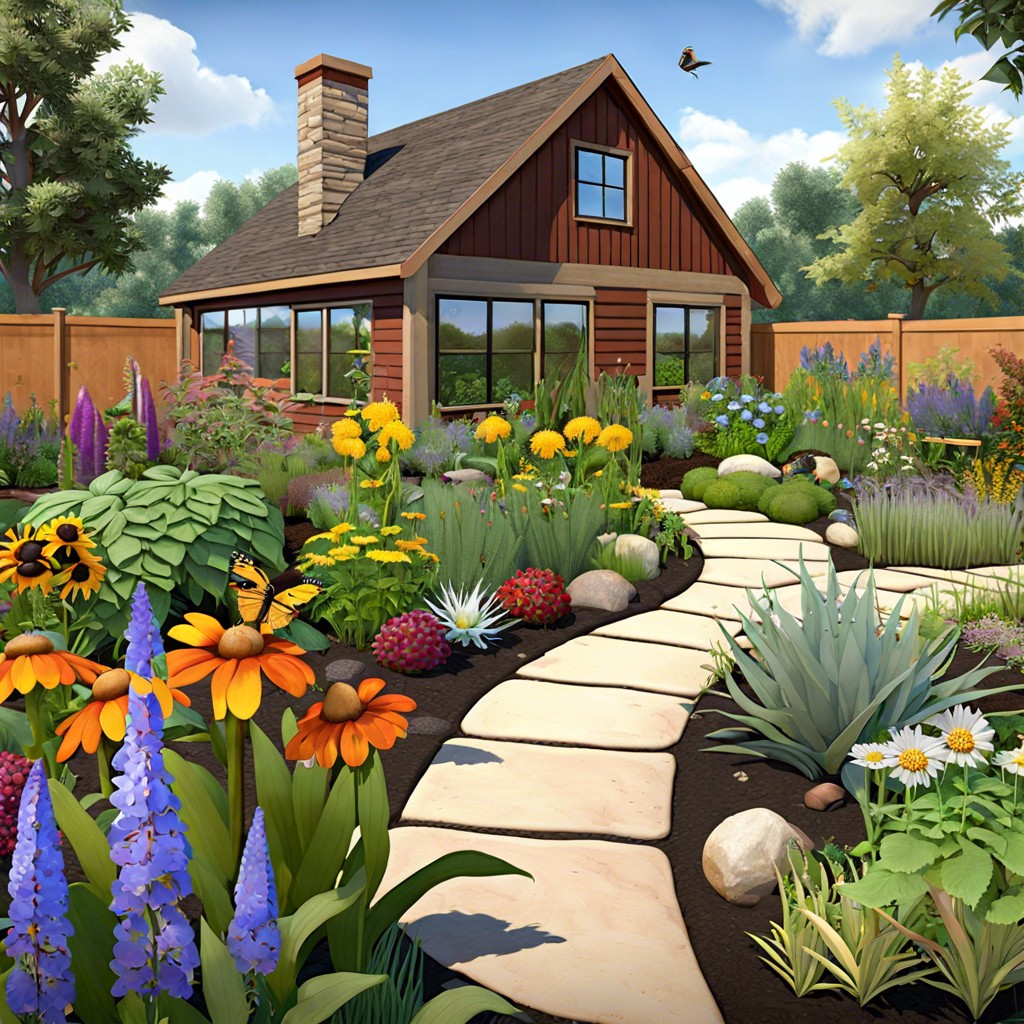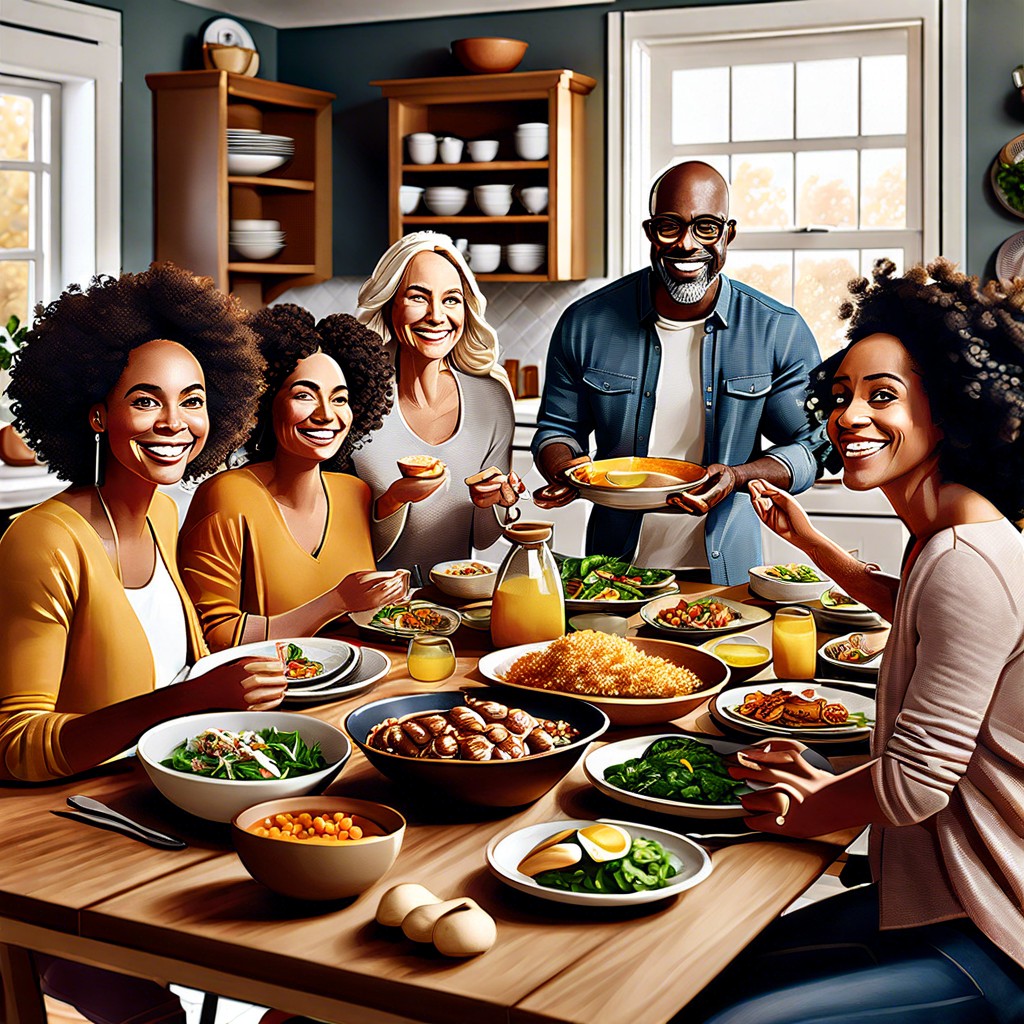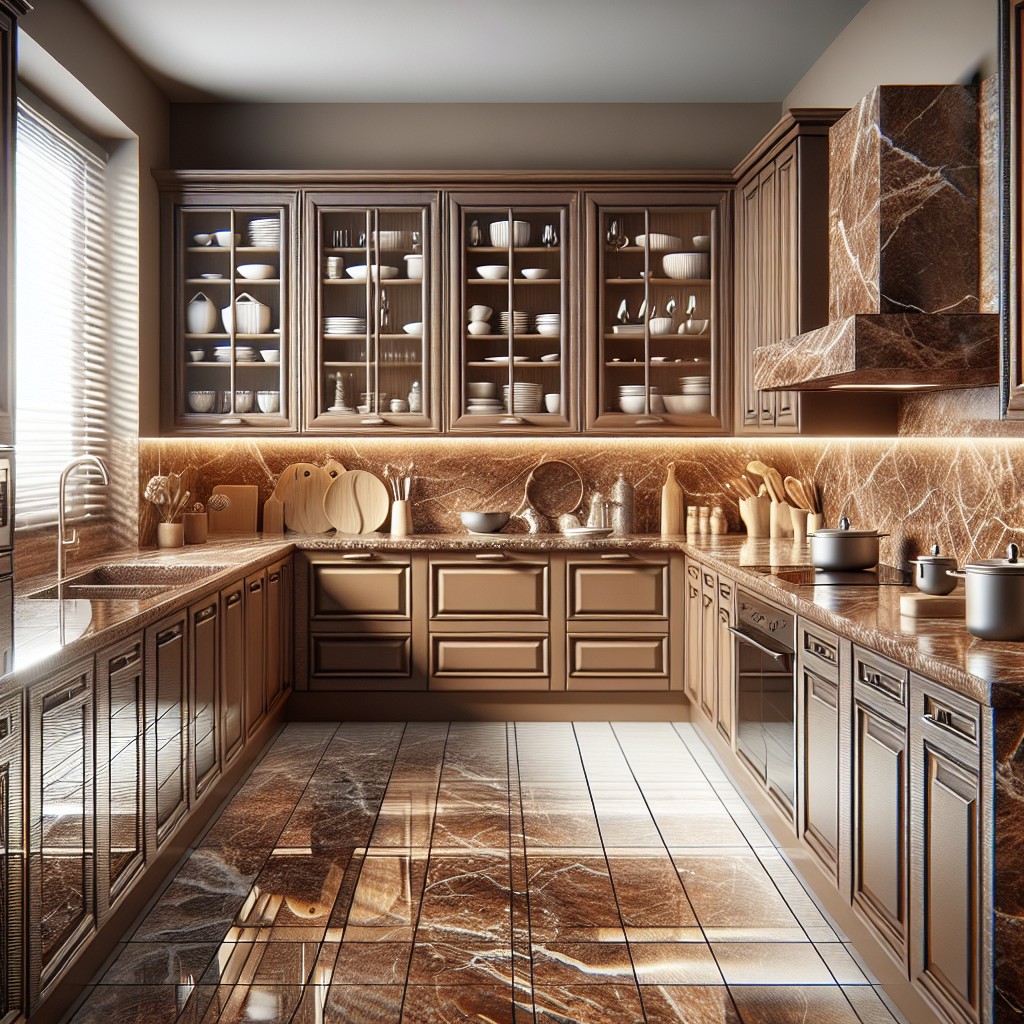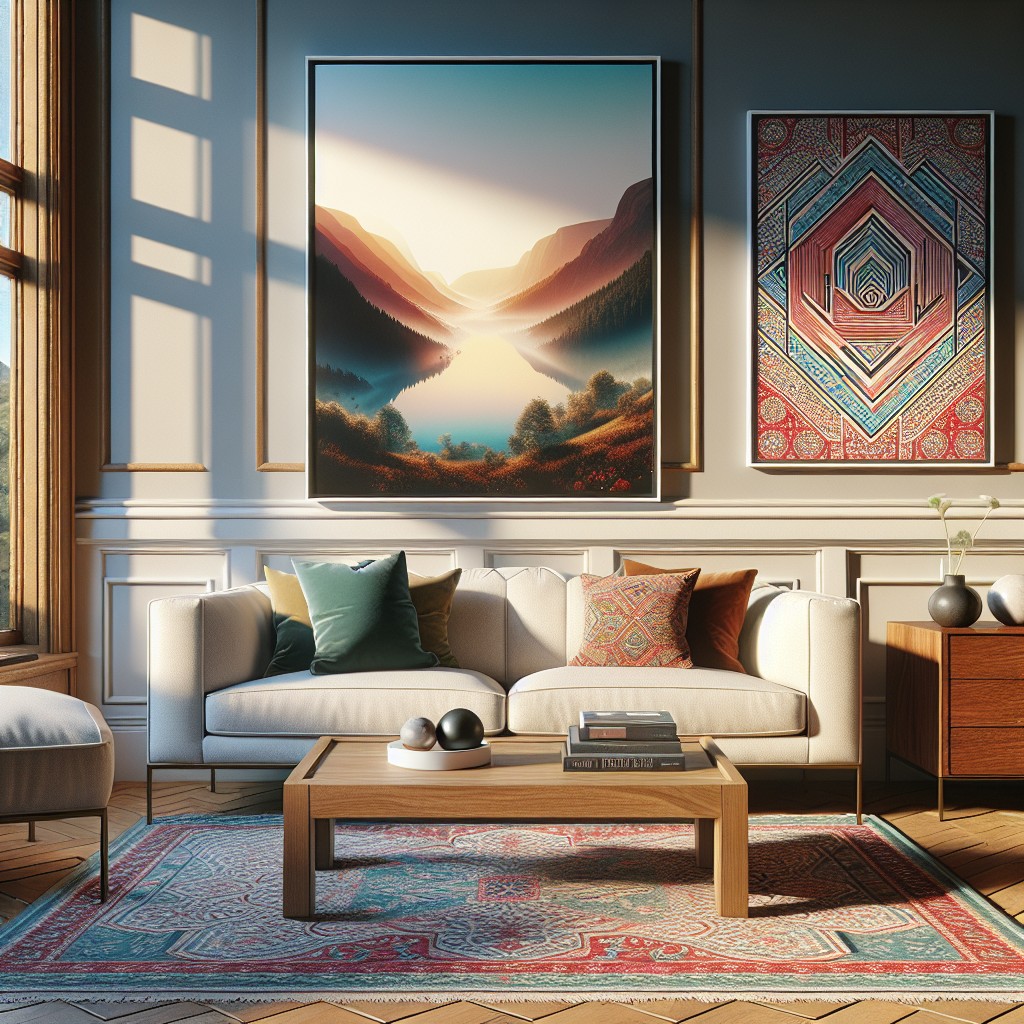Last updated on
Exploring dining room accent wall ideas is crucial because they have the power to transform an ordinary room into an extraordinary dining experience.
I’m proud to have crafted this guide on “20 Dining Room Accent Wall Ideas: Ultimate Guide to Striking Spaces,” complete with unique designs, and I sincerely hope you find it as inspiring and fun to explore as I did creating it.
Creating an accent wall in your dining room can dramatically enhance the aesthetic appeal of the space. Whether you prefer a subtle touch or a bold statement, there are countless options to choose from.
From textured paint, wallpaper designs, to innovative uses of wood and metal, the possibilities are endless.
In this article, we delve into a variety of dining room accent wall ideas, exploring different materials, styles, and color schemes.
We also provide useful tips on how to choose the right accent wall to complement your existing décor and personal style.
So, get ready to transform your dining room into a visually stunning space that leaves a lasting impression on your guests.
What's Inside
Bold Wallpaper
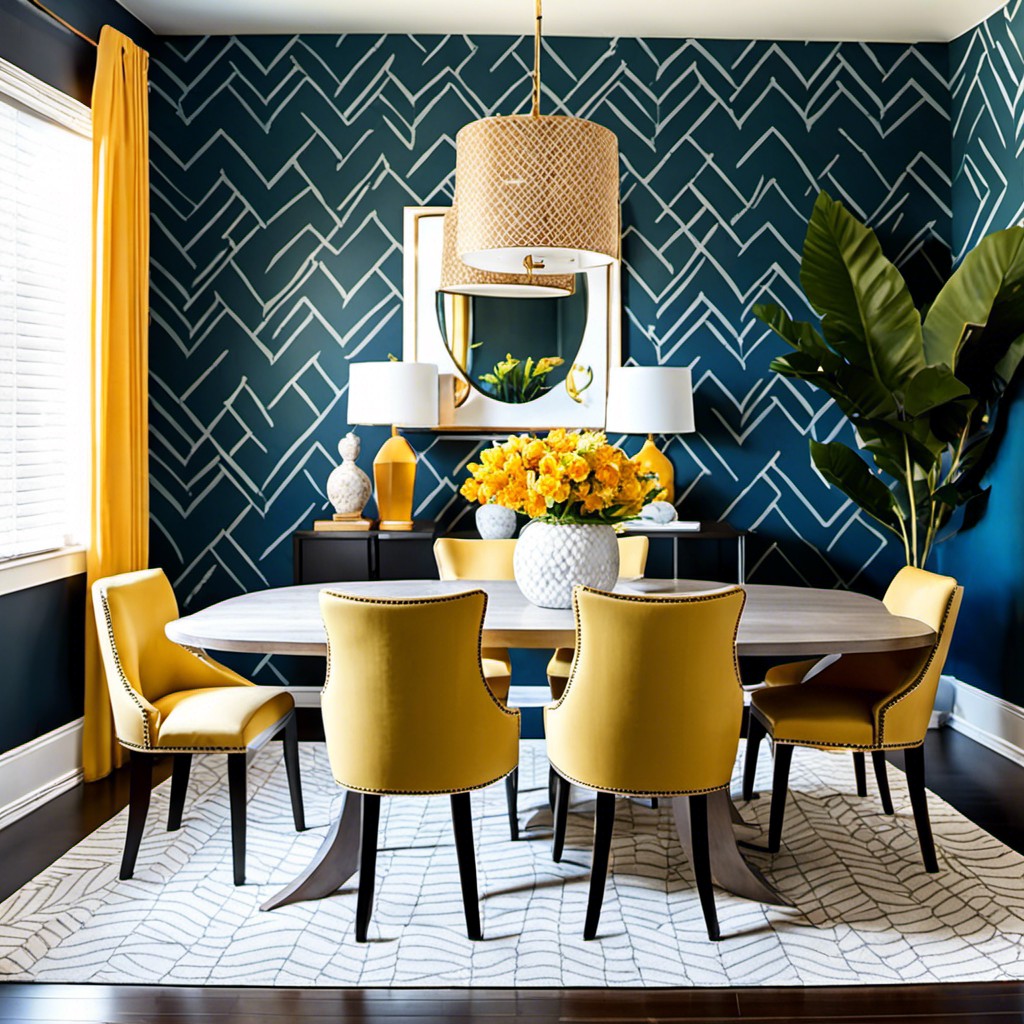
Immersing your dining room wall in a wallpaper that features bold patterns or vibrant colors can instantly elevate the room’s persona.
From classic damask prints to trendy tropical motifs, the array of options is virtually endless.
To successfully incorporate bold wallpaper, there are a few considerations:
- Scale – If you have a small room, opt for designs with smaller motifs to avoid overwhelm. In larger spaces, you can afford more panoramic patterns.
- Colour – The wallpaper color should complement, not compete with your existing decor. Harmonious tones create a visually coherent space.
- Quality – Invest in high-quality, durable wallpaper. Look for options that are easy to clean and won’t fade over time, ensuring your accent wall remains impactful for years.
- Positioning – Place the wallpaper on a wall that you want to highlight. It could be the wall behind your dining table or buffet.
- Professional Installation – Since this wallpaper would be a focal point, it’s wise to go for a professional installation to ensure seamless application.
Remember, the key to nailing this decor idea is balance. Too much of a bold pattern can be overwhelming, so confine its use to just one wall instead of all four.
Brick Veneer
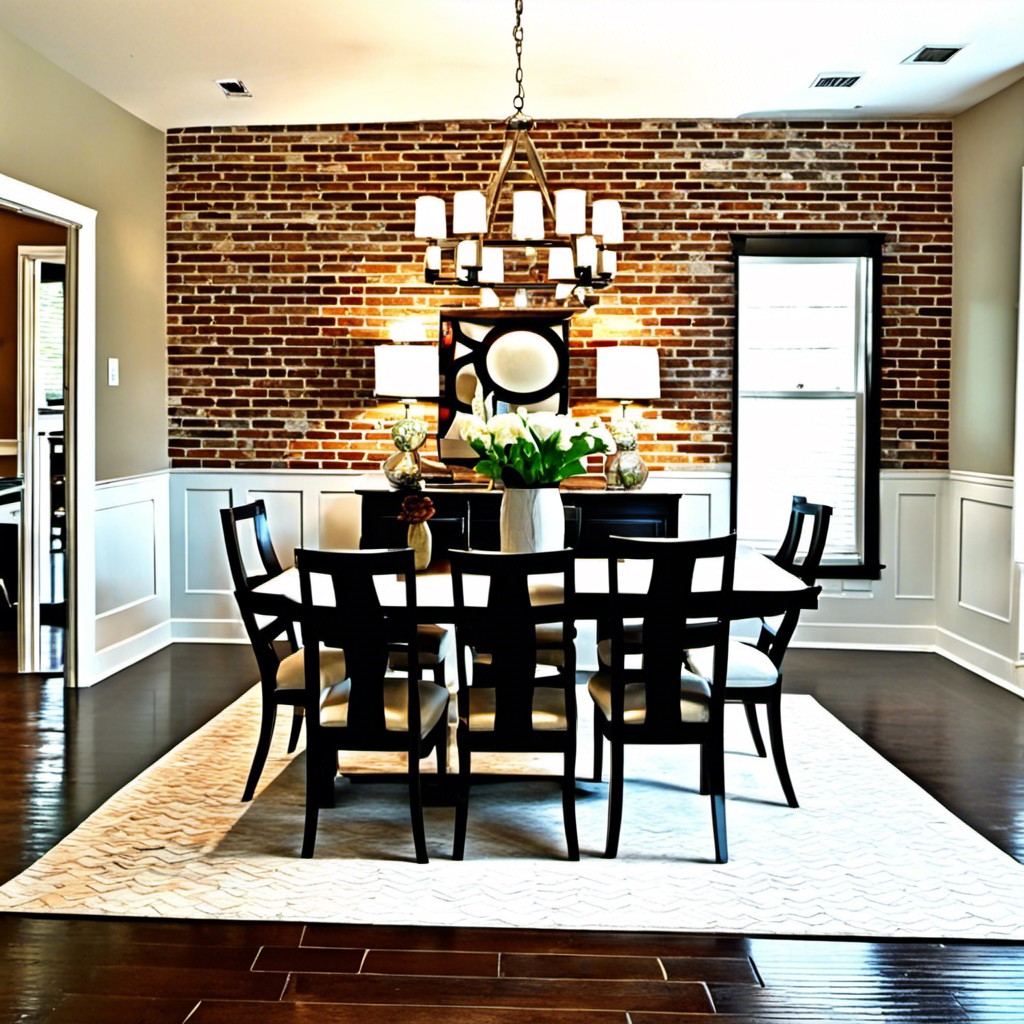
Brick veneer, while maintaining the aesthetics of traditional brick, provides a more cost-effective and manageable approach. It contributes a rustic charm to any dining room, and can range from classic reddish-brown, to white, for a more modern look.
This wall idea is particularly fitting if your dining room follows an industrial or farmhouse style. It’s simple to install, and requires very little maintenance. Just a simple wipe-down.
Also, this approach offers additional insulation, reducing energy costs. So, not only do you receive aesthetic gains, you also achieve practical benefits.
Chalkboard Paint
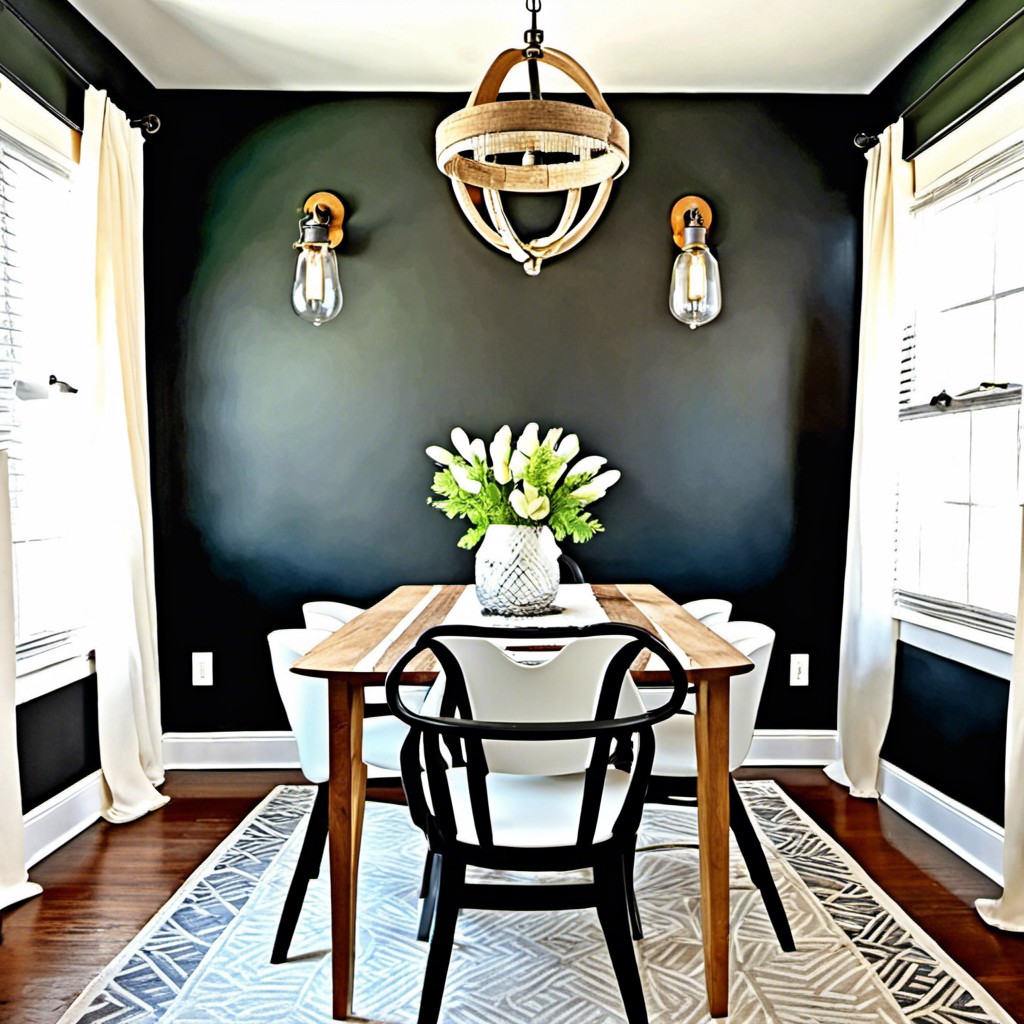
Applying chalkboard paint offers a fun and functional feature. It allows for creativity and personal expression, as well as serving as a convenient spot for jotting down meal plans or shopping lists. Moreover, it’s an interactive element for children to get engaged with the dinner planning or drawing while the adults prepare a meal.
For a chic look, consider using this paint selectively create a large rectangle shape on the wall rather than covering the entire wall. A strong advantage is the ability to change the design as desired, whether that’s a beautiful menu for a dinner party or personal artwork.
Pro tip: Use a clear chalkboard paint to keep your existing wall color or choose from numerous colored varieties for a more dramatic effect.
To maintain, simply wipe with a damp cloth and dry thoroughly before the next use – ensuring your chalkboard wall always looks its best!
Floor-to-ceiling Shelving
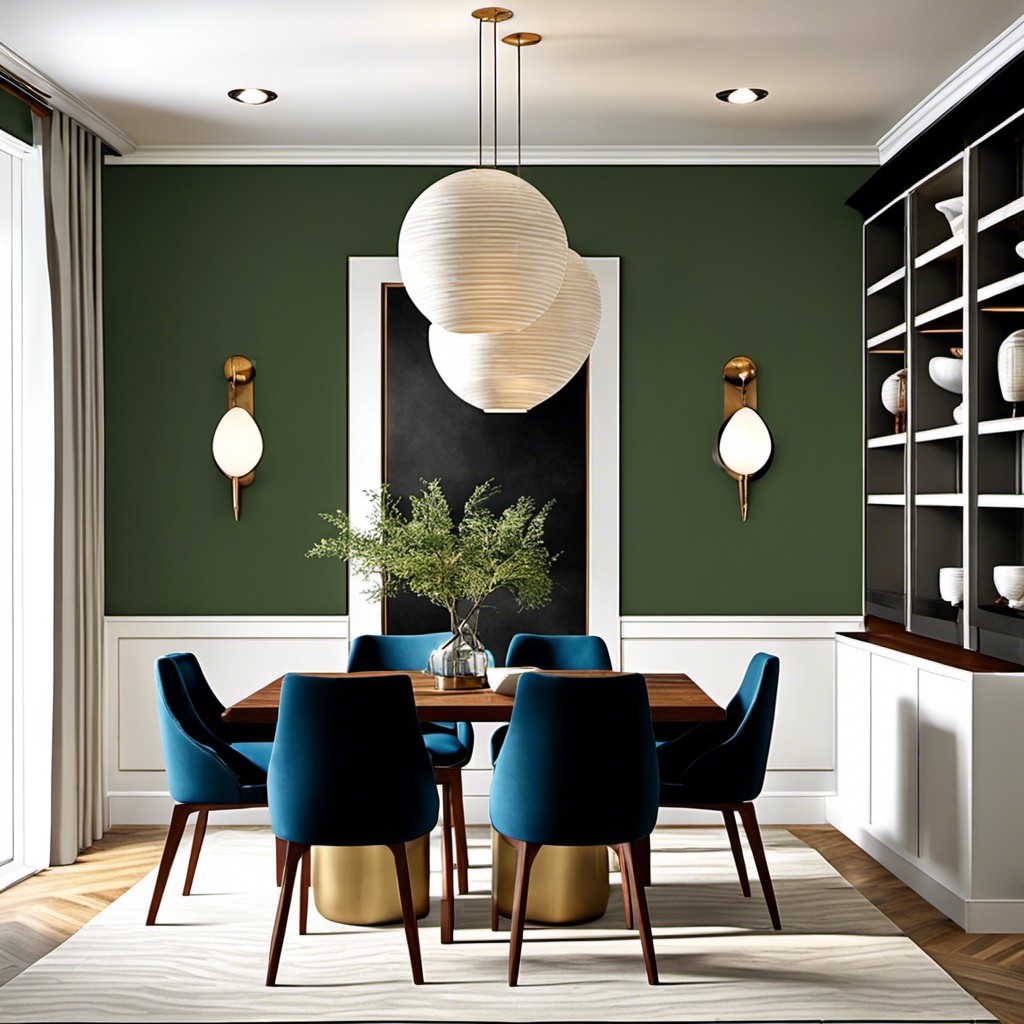
A dramatic transformation that adds both charm and functionality, floor-to-ceiling shelving serves as an exquisite blend between decor and storage. Installing such racks can display everything from books and collectibles to dinnerware and glassware.
This element not only saves floor space but also anchors the dining room, drawing the eyes upwards thereby creating a sense of verticality and space. Choose materials and colors that compliment your existing decor — wood for warm undertones or metal for an industrial vibe. Play with asymmetrical or streamlined designs based on your taste.
Add a rolling ladder for an extra touch of sophistication while also allowing easy access to top shelves. Incorporate accent lighting into your shelves for an inviting ambiance, especially during dinner parties.
Geometric Patterns

Geometric patterns offer a modern and edgy feel to a dining space. From arresting hexagons to tantalizing triangles and stylish squares, these patterns make quite the visual impact. They can be introduced through wallpaper, paint, or even wall art. It’s possible to just incorporate this trend on a single wall for a less dramatic effect.
In terms of colors, a monochromatic scheme often works well to create a cohesive and elegant style. But for those looking for a pop of vibrancy, incorporating bold and contrasting colors can truly make the patterns stand out. For a classic touch, a black and white geometric pattern never goes out of style.
Finally, it’s important to balance the boldness of these patterns with simple furniture and décor. Neutral-colored dining furniture or minimalist décor items can help create equilibrium in the space.
Hanging Vintage Plates
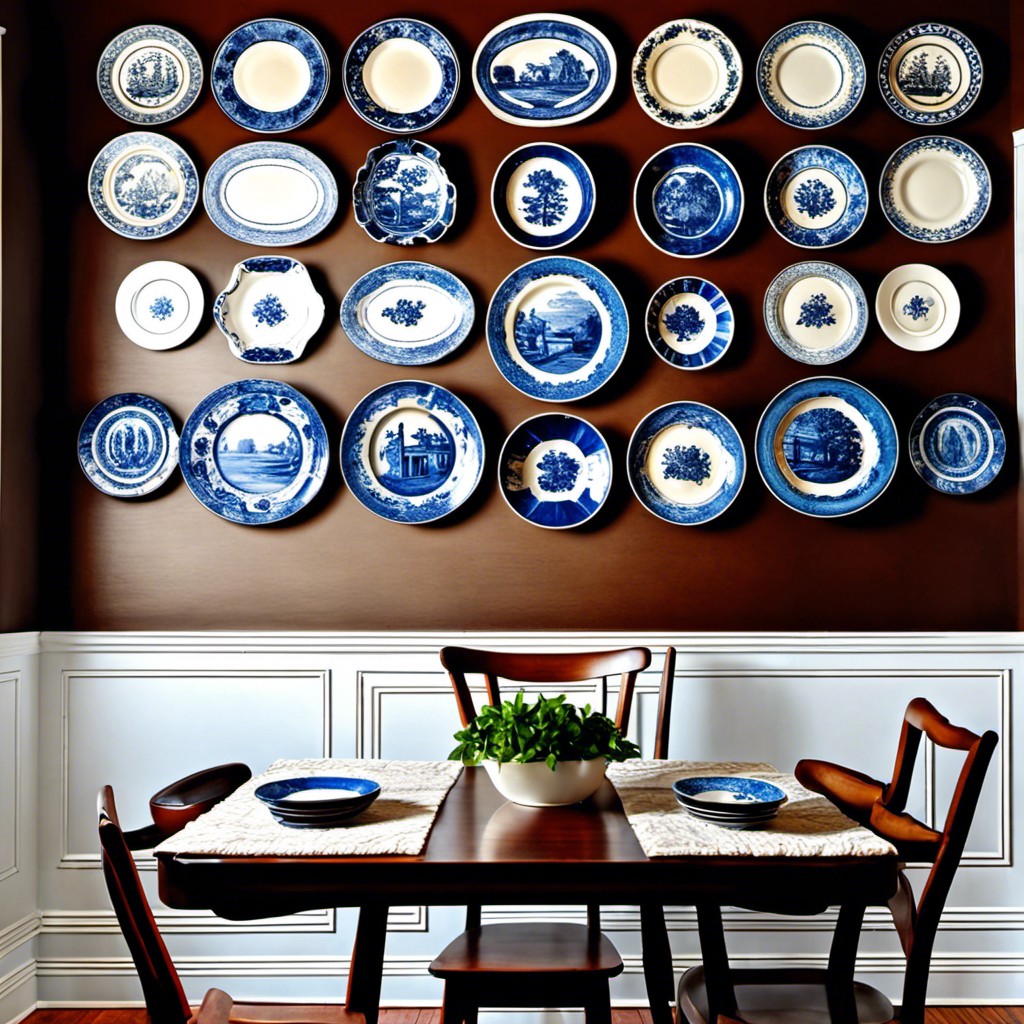
Delivering a unified yet unique statement, a selection from different periods and styles serves as an artistic display. You might incorporate hand-me-downs from relatives, pieces bought from antique stores, or simple finds from yard sales.
To create a visually pleasing arrangement, cluster in odd numbers and balance ornate pieces with simpler ones. Consider a central, larger plate surrounded by smaller ones. Use plate hangers that match the wall color, ensuring they blend into the background to keep the focus on the plates.
Mirrored Wall
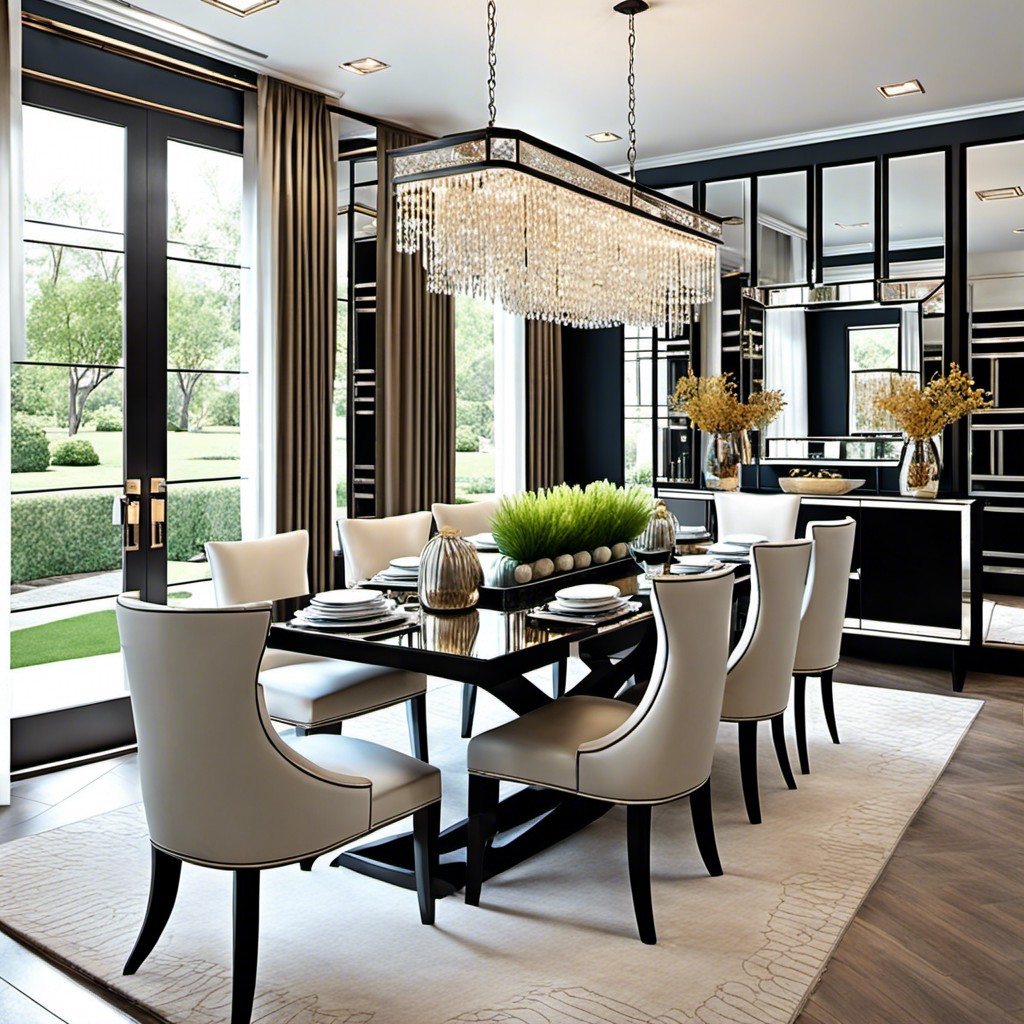
Mirrored walls are an excellent choice to amplify natural light and make the dining room appear larger. They add a touch of luxury while giving the space a modern, aesthetic appeal.
1. Boost Natural Light: Mirrors reflect light, illuminating darker corners during the day.
2. Create Illusion of Space: Large or strategically placed mirrors can double the perceived area of a room, perfect for smaller dining spaces.
3. Showcase Artwork: Positioned right, a mirror can be used to reflect and emphasize artwork or other focal points.
4. Design Flexibility: Mirrors can be traditional, modern, large, small, or even mixed for an eclectic look.
5. Easy Maintenance: With a quick wipe down, they are easy to keep clean and smudge-free.
Be creative with mirror placements and sizes for the best effect. Remember to consider what the mirror will reflect to maximize its appeal.
Remember, less can often be more, overloading the room with mirrors might overwhelm the eye, so balance is key. When executed well, mirrors can transform a dining area, opening it up and serving multiple functions.
Oversized Wall Art
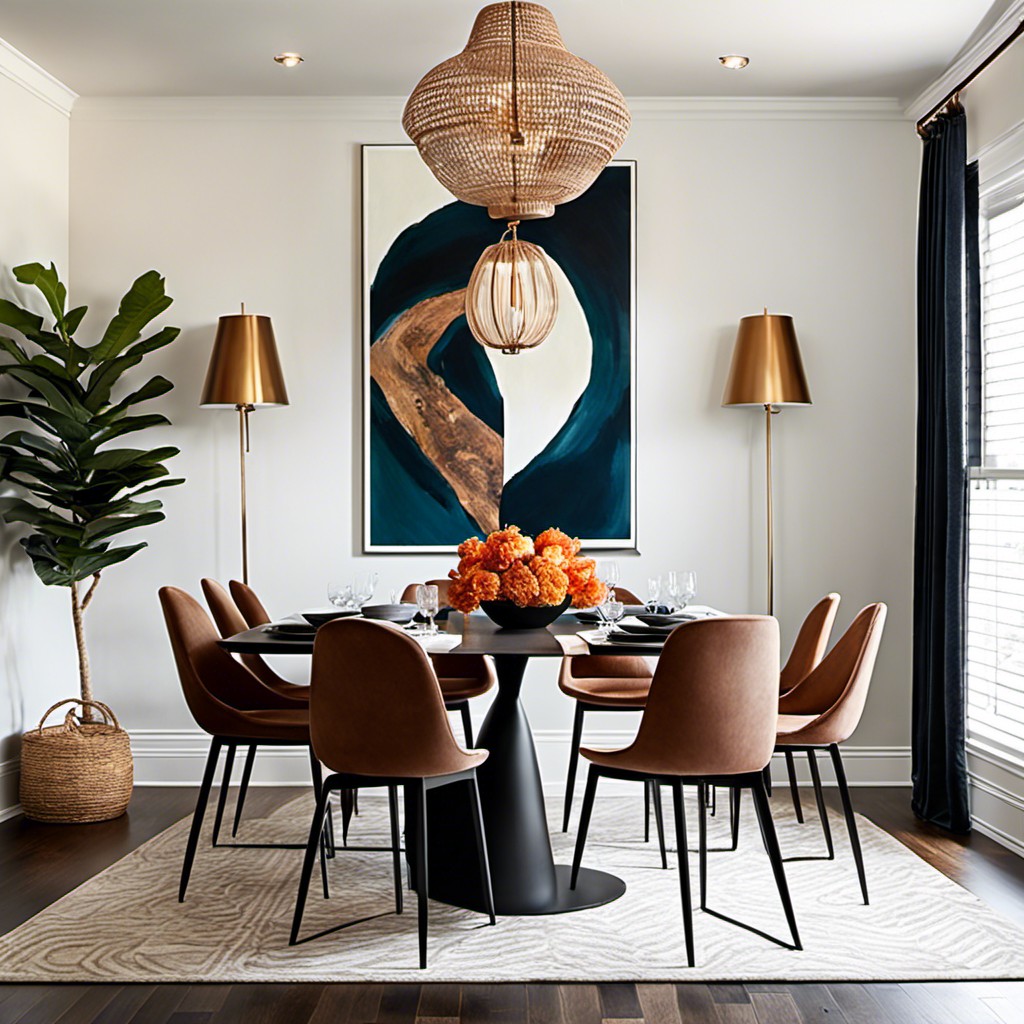
Choosing a large-scale piece accomplishes multiple objectives. Firstly, it creates a statement, dominating the visual field and drawing attention almost instantly. Secondly, it simplifies the decorating process, as the eye tends to focus more on the artwork than any smaller decor surrounding it.
When selecting an oversized piece, some considerations include:
- Color Scheme: It’s recommended to match or complement the colors in the art to those within the room.
- Proportions: While the artwork should be substantial, it should also be an appropriate size for the wall. A good rule of thumb is it should take up about two-thirds to three-quarters of wall space.
- Theme: The piece should align with the overall aesthetic of the room. Modern art suits contemporary spaces, while classical pieces often blend well in traditional environments.
- Positioning: The center of the artwork should be at eye-level, which is generally 56 to 60 inches from the floor.
Remember, the focus is to evoke emotion and heighten visual interest, delivering aesthetic cohesiveness with the existing decor.
Painted Mural
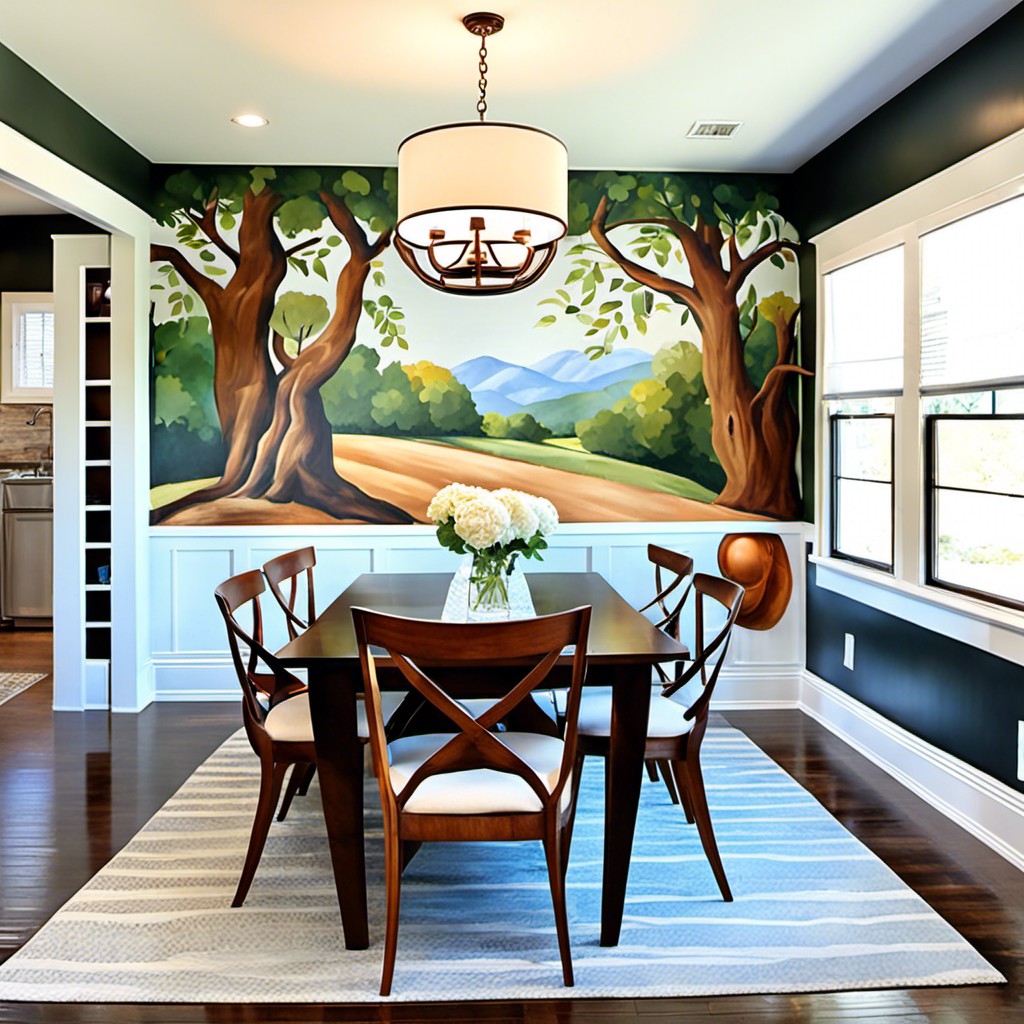
Delving into self-expression through an artistic touch, painted murals breathe life into your dining area. Here are a few key considerations:
1. Theme Selection: Choose your theme wisely. It can be anything from landscapes, abstract forms, to your favorite pieces of art.
2. Scale and Composition: Balance is fundamental. The mural should neither overwhelm nor get lost. It’s not simply size but the distribution and connection of different elements.
3. Color Palette: Stay cohesive. The colors in your mural should complement your dining room’s overall color scheme.
4. Professional Assistance: Depending on the complexity, hiring an artist might be the best option.
Remember, this is your space. Be bold and personal with your mural. Reflecting your unique tastes and interests, it transforms your dining room into an inviting, entertaining, and aesthetically pleasing space.
Reclaimed Wood Wall
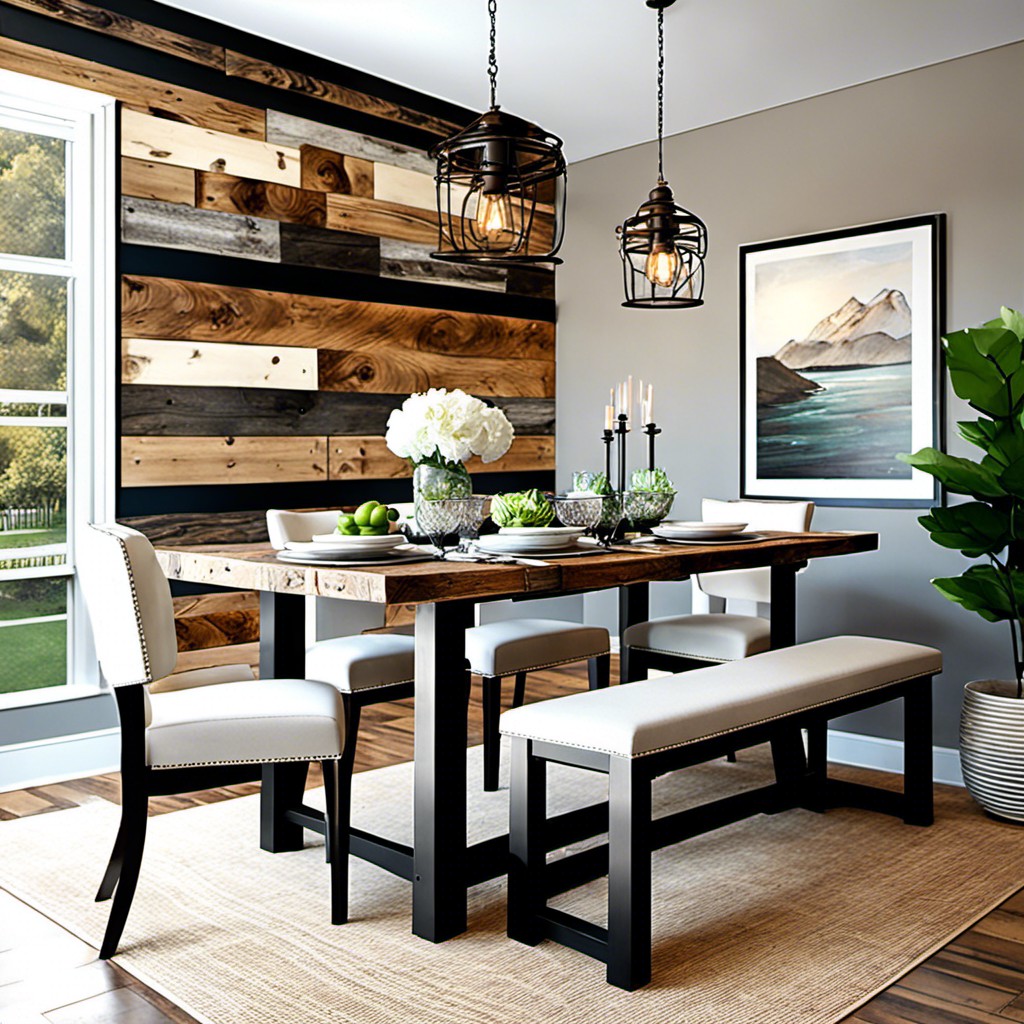
Incorporating reclaimed wood as an accent wall adds an inviting warmth and rustic charm to your dining room. This environmentally-friendly option not only recycles old materials but also provides a timeless aesthetic.
Whether you opt for a diverse mix of wood shades or stick to one hue for a monochrome look, you’re guaranteed to create an eye-catching piece. The wood can be arranged in a horizontal or vertical manner, or alternatively in a herringbone or chevron pattern for a more captivating display.
Staining or painting the wood can further complement the rest of your dining room décor. For an extra flair, consider incorporating shelving into the design, this not only adds functionality but also gives you an opportunity to add personalized decor elements that reflect your style.
Using proper sealant ensures that the wood retains its finish and is protected from potential damage.
Striped Paint
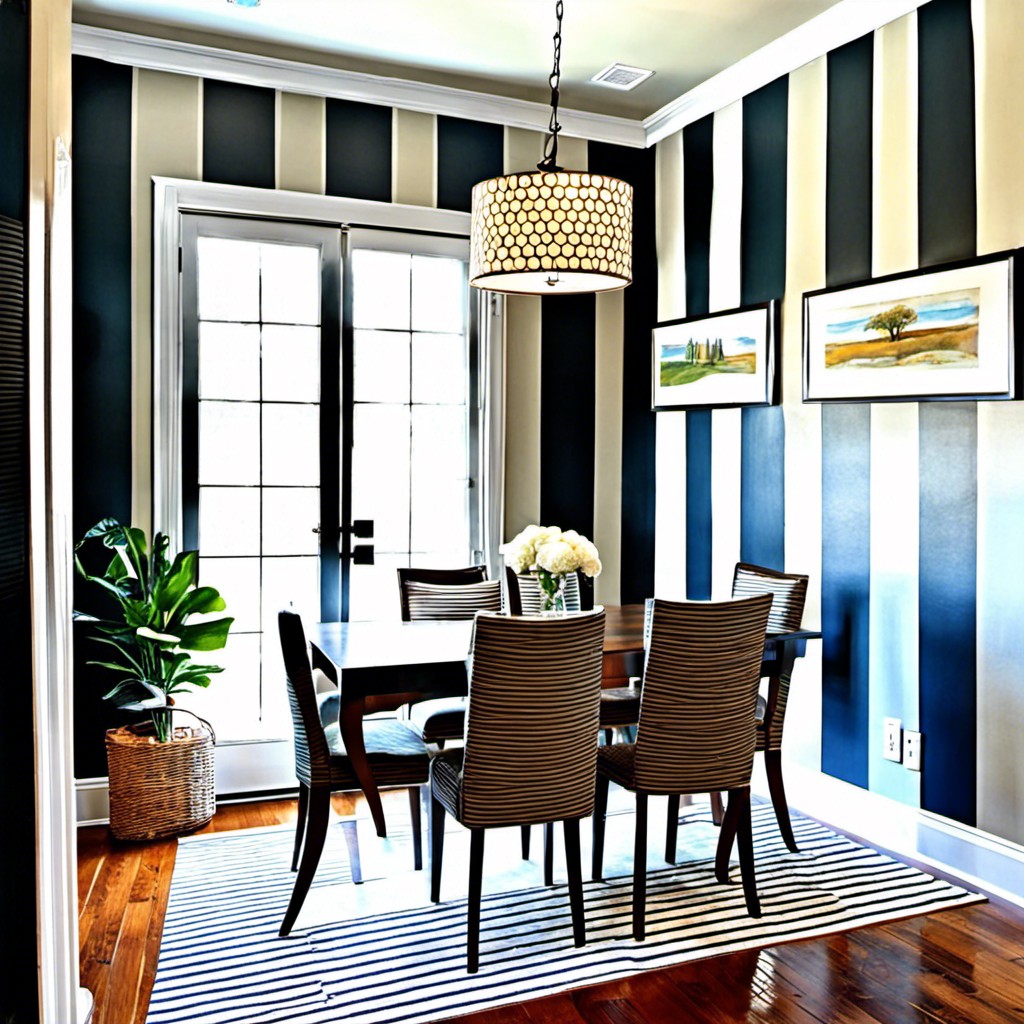
When it comes to creating a dynamic yet elegant accent wall, stripes are a timeless choice. The technique is flexible, allowing for customization in terms of color, width, and orientation of the lines.
Remember, vertical stripes can enhance the room’s height while horizontal ones may widen the appearance of the space.
For subtlety, use two shades of the same color. A daring, high contrast look could involve two distinct colors, such as black and white. Try painting stripes freehand for a boho look or use tape for precision. Metallic finishes or glazes over one stripe can add an unexpected twist.
Stripes create movement and depth, effectively transforming the dining area into an inviting space.
Textured Plaster
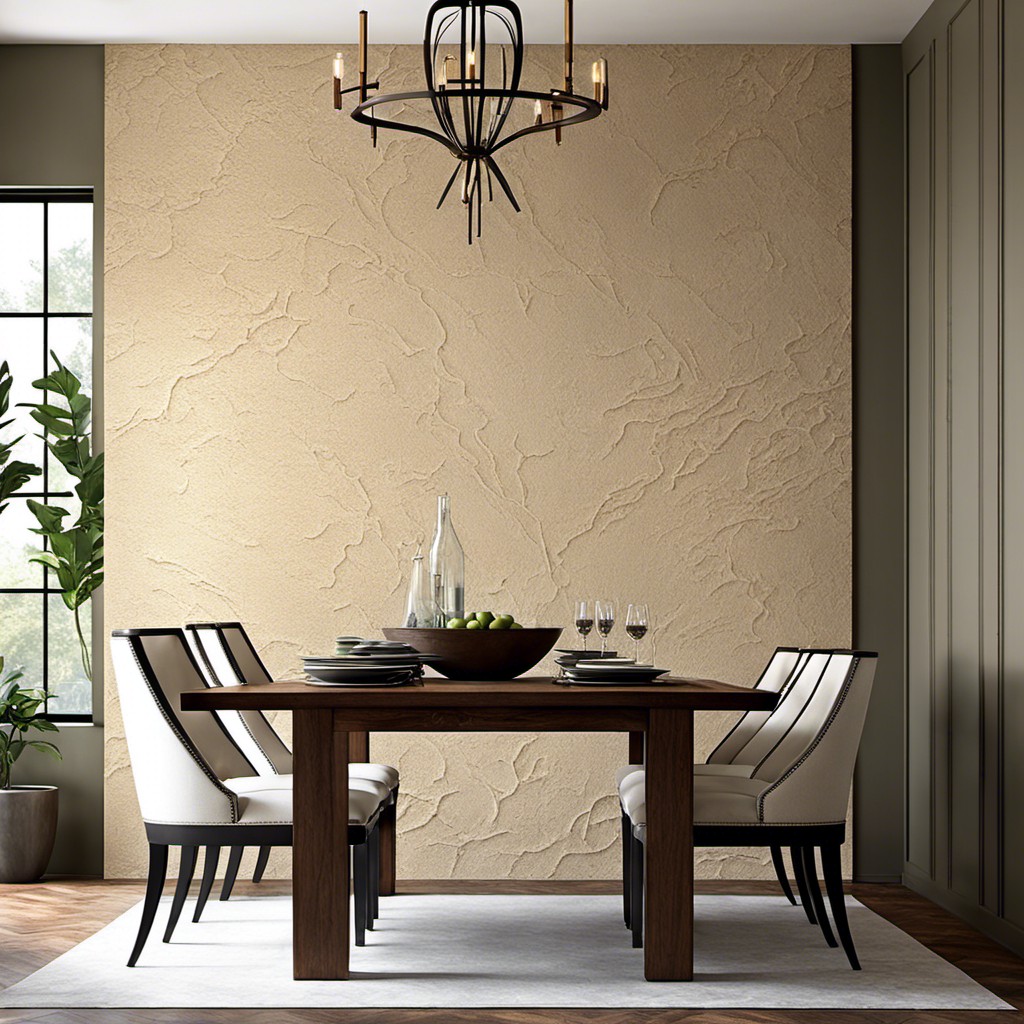
Adding a dimensional effect to your dining room space, textured plaster can instantly morph drab walls into a tactile canvas. Here’s how to make the best use of this:
1. Technique matters: From smooth and subtle to rough and rustic, the application technique used can significantly vary the result. Stipple, swirl, or rag rolling can all create unique looks.
2. Play with color: While traditional white can provide a modern and minimalist aesthetic, colored textured plaster adds personality, depth, and zest to a room.
3. Combine with lighting: Soft, focused lights can enhance the wall texture, creating intriguing shadow patterns that bring dynamics to the ambiance.
4. Consider one wall: You don’t have to cover all four walls. Just one accent wall with textured plaster can become a statement piece in your dining room.
Remember, textured plaster requires the right blend of skill and patience to pull off, so consider hiring a professional if unsure about taking on the task yourself. It’s all about making a space that resonates personally and brings joy every time you dine in.
Tile Mosaics
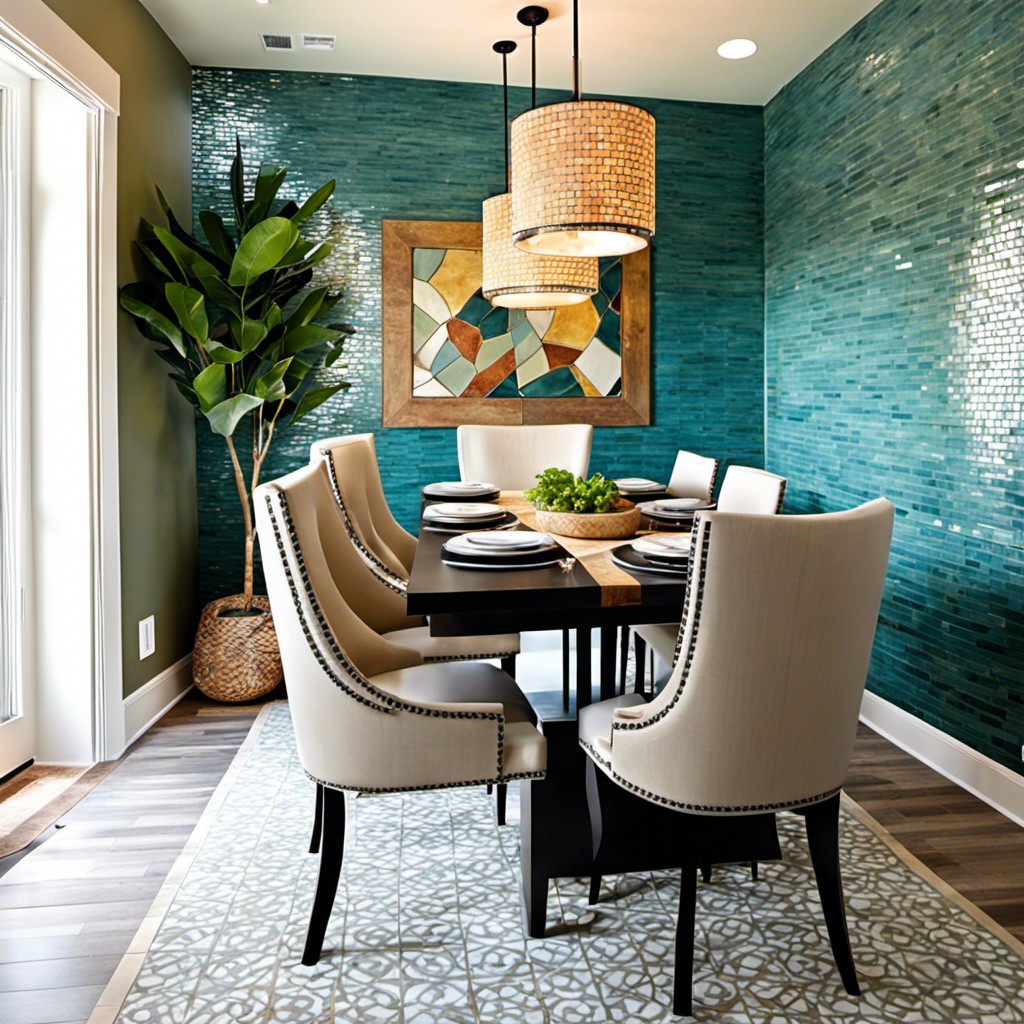
Creating a tile mosaic can turn a dining room accent wall into an intricate work of art. There are endless possibilities depending on design styles, color preferences, and chosen patterns. Glazed ceramic tiles can add a shimmering tone, while natural stone or marble tiles offer a more subdued and elegant touch.
Consider random patterns to keep the eye moving and avoid monotony. Alternatively, determine a focal point and arrange tiles radiating from it for a dramatic effect.
Ensure the sizing fits the scale of the room. Smaller, mosaic tiles might be perfect for a more intimate dining space, while larger tiles can fill up and add story to a vast, open room. For a modern twist, try varying the size and shape of the tiles within the pattern.
Installation can be challenging, especially for intricate designs. It’s recommended to hire a professional to eliminate any chance of misalignment. Regular maintenance is ideal for preserving the sheen, ensuring the wall stays as striking as the day it was installed.
Upholstered Wall

For an opulent and stylish statement, nothing beats adding upholstery to your dining room’s accent wall. This choice brings warmth, texture, and a sense of luxury. Here are a few key points to keep in mind when considering this option:
- Texture: Upholstery comes in a myriad of textures, from velvet to linen, that can instantly elevate your dining space.
- Sound absorption: It can also serve a dual purpose by dampening noise, which is optimal if you frequently host dinner parties.
- Color: A well-chosen color palette can perfectly complement your dining table and chairs, creating a harmonious visual appeal.
- Pattern: By selecting a patterned fabric, you can introduce an additional stylistic element to your room.
- Maintenance: Keep in mind that maintenance can be higher compared to other wall treatments. Consider using performance fabric for durability and ease of cleaning.
Remember, balance is crucial when adding significant visual interest; you would want to keep your other walls and decor simple and neutral.
Wine Rack Display
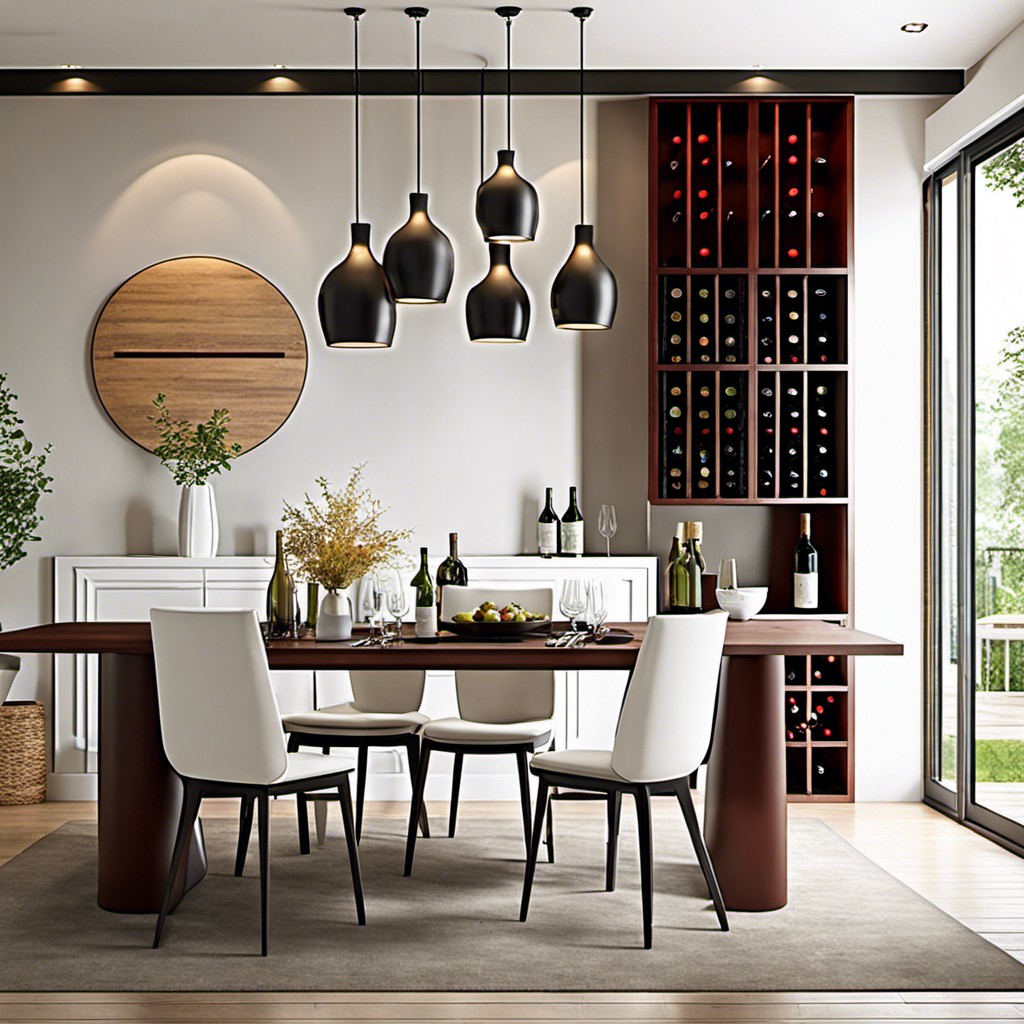
Transforming one side of your dining room into a wine rack display adds both aesthetic appeal and functionality. Here are a few points to consider:
1. Select the correct rack: Racks come in various styles and materials, such as wood, metal, or even acrylic.
2. Positioning: Ensure the rack is placed away from direct sunlight and sources of heat to keep wines at their best.
3. Accessibility: Make sure the rack is within easy reach when serving meals.
4. Capacity: Choose a rack size that caters to your wine collection’s potential growth.
5. Lighting: Adequate illumination can make the bottles shine and increase the accent wall’s dramatic effect.
And remember, this feature functions best in dining rooms used frequently, to keep your wine collection in proper rotation.
Abstract Wall Decals
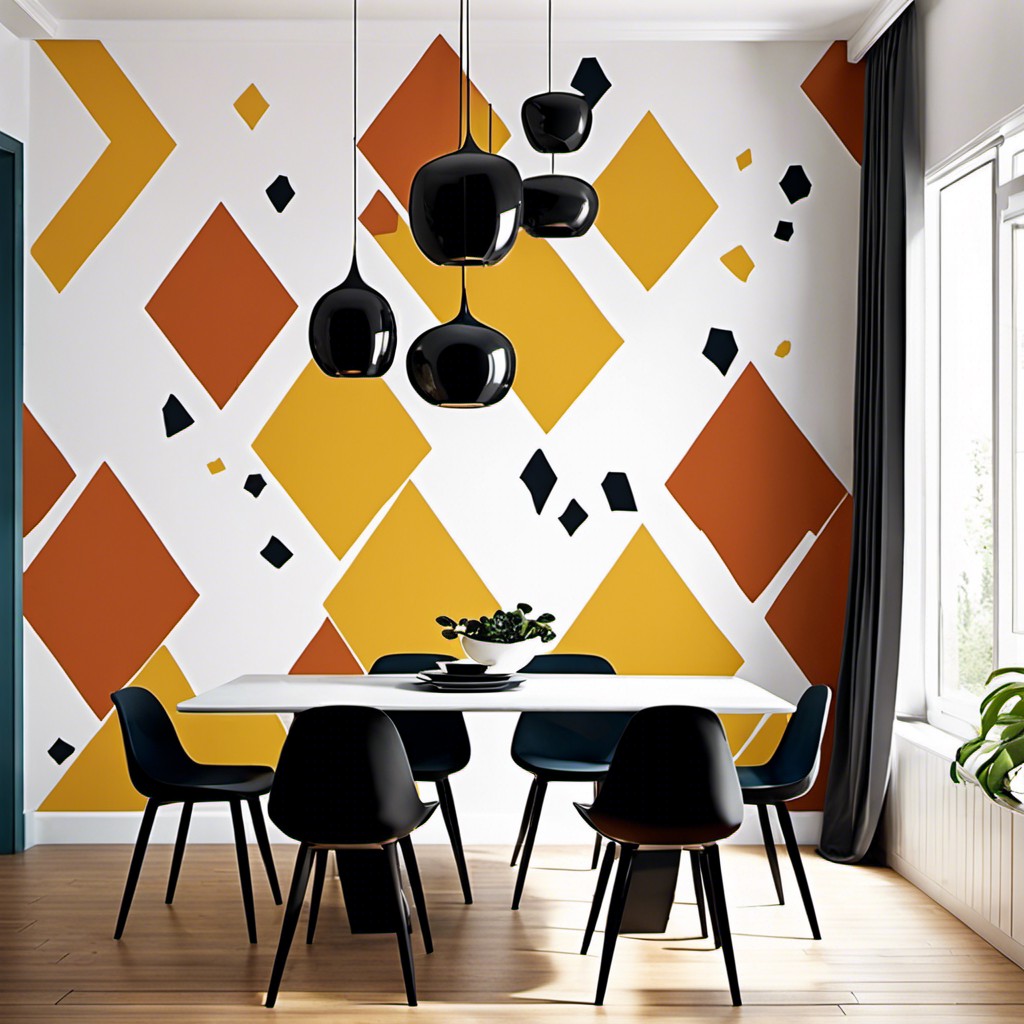
Injecting a creative edge into your dining room is easily achieved with abstract wall decals. They offer a transformative power when professionally layered over a wall. These adhesive designs can be simple geometric shapes with mmuted pastel tones, or bold and dynamic patterns with vibrant colors.
Abstract wall decals can suit varying aesthetics, be it the geometrically pleasing Scandinavian design, the bold black and white in a modern theme, or a dash of golden exotic elements for a Bohemian style. Moreover, it’s a cost-effective solution compared to a full wall repaint or wallpaper application. The decals are easy to apply, remove, or reposition, making them perfect for those who like to keep things fresh every couple of years or moving their dining setup around.
It’s also an opportunity to bring in a third dimension to your space. Choose decals with contrasting colors to your walls to create depth. Combining different sizes or shapes of decals can also add visual interest.
Remember, balance is key when it comes to abstract wall decals. Avoid overcrowding the space with intricate designs or overly bold tones. When chosen and positioned wisely, abstract wall decals can harmoniously coexist with other decorations in your dining room.
Dark Color Contrast
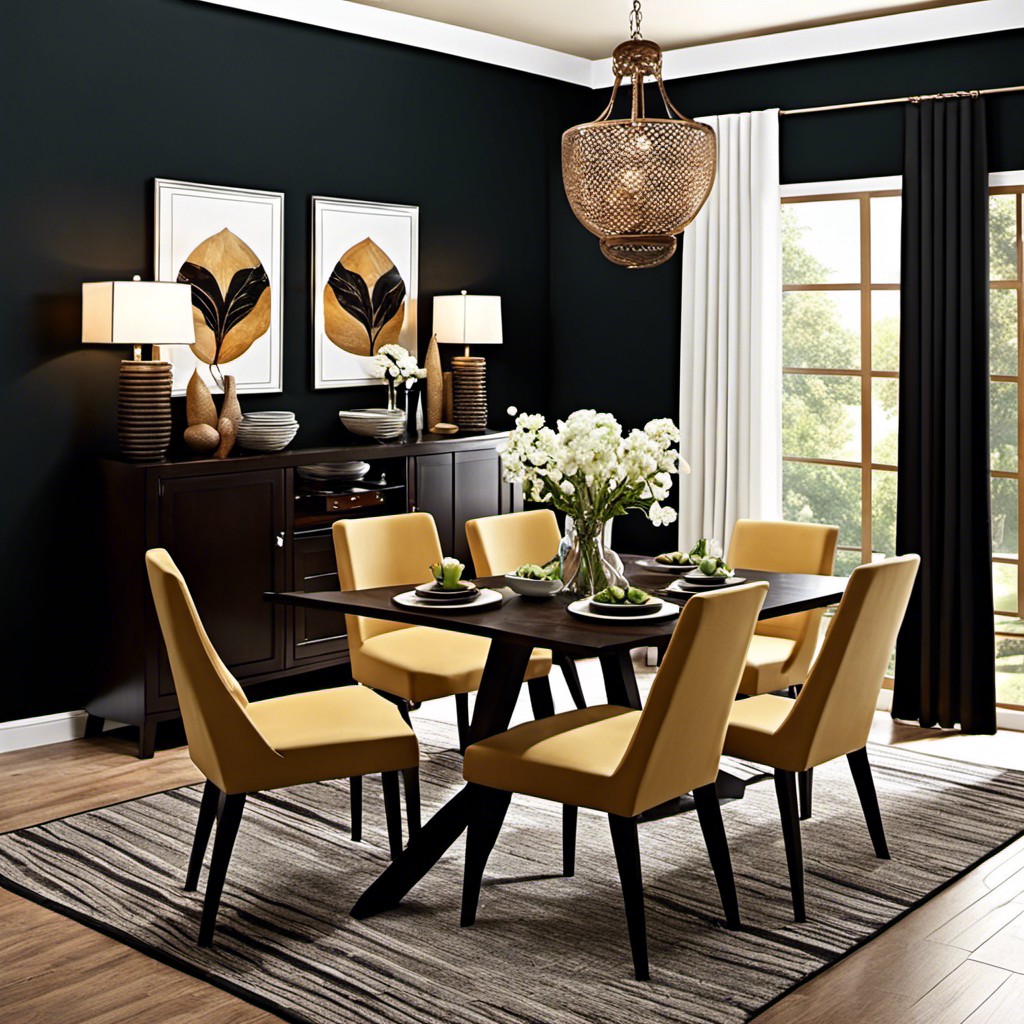
Opting for a darker hue can truly highlight the formality of a dining space, especially when contrasted with lighter furnishings. For the most effective results, your wall color choice should be several shades darker than your decor. A deep navy or rich burgundy creates an elegant atmosphere and allows your furniture and wall hangings to pop.
Consider the following:
- 1. Maintain balance by keeping the rest of the room light and neutral.
- 2. Employ metallic accents like brass or silver for an extra layer of contrast.
- 3. Ensure appropriate lighting to keep the dark color from absorbing too much light.
- 4. Use a gloss finish to reflect light and add dimension to the space.
Floral Stencil Art

Differing from traditional wallpaper or straightforward paint jobs, floral stencil art provides a customizable and creative approach to accent walls. It offers the flexibility to choose your colors and patterns, matching perfectly with your dining room’s existing decor.
Utilizing repositionable stencils can make this DIY project straightforward even for beginners. Neatly apply the stencil to the desired wall, paint over, then carefully remove to reveal your design. This hands-on approach allows complex patterns and intricate designs, like blossoms or vines, at a fraction of the cost of designer wallpaper.
For those wishing to incorporate a touch of nature in their space with personal customization, floral stencil art is an ideal choice.
Photo Gallery Wall
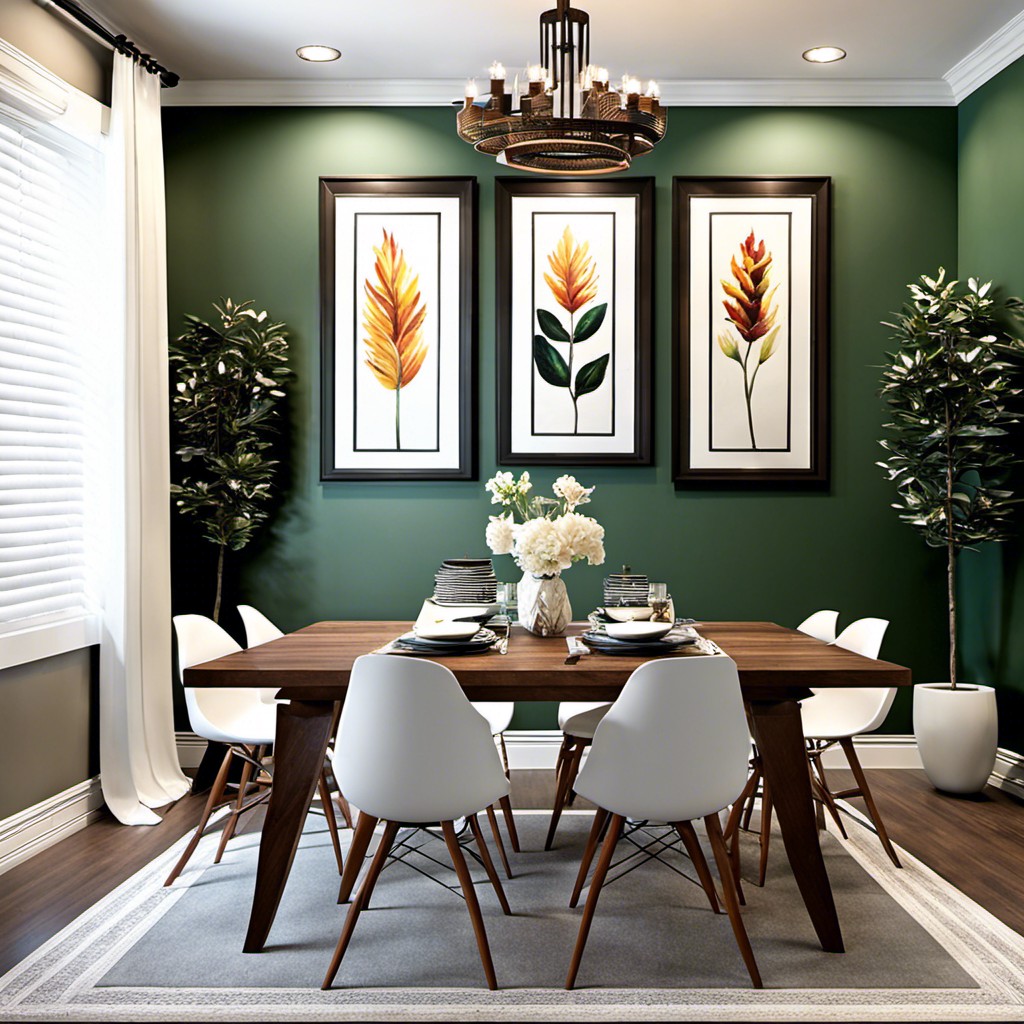
Creating your gallery starts with selecting the right frames, varying sizes to make the layout more dynamic. Black, white, or wooden frames generate a clean, classic look, while colorful or metallic ones can add a pop of personality. The contents; family portraits, vacation photos, or favorite prints, can help dictate the theme.
There’s no need to follow the traditional straight line formation. A random layout provides a more modern, relaxed vibe. Yet, balance remains crucial, distributing colors and sizes evenly to avoid excess focal points.
Remember the rule of thirds, dividing the wall into grids to help position your frames in harmonious alignment. Furthermore, the frames should be hung at eye level to create the best visual impact, giving your dining room a personal touch that also doubles as a conversation starter.
In terms of arrangement, larger pieces serve as anchors. Surround them with smaller ones to form clusters. Thick, thin, double or collage frames also introduce texture variation. Finally, critically evaluate from a distance for any necessary adjustments before enjoying your personalized dining room accent wall!
Unique Wall Sconces
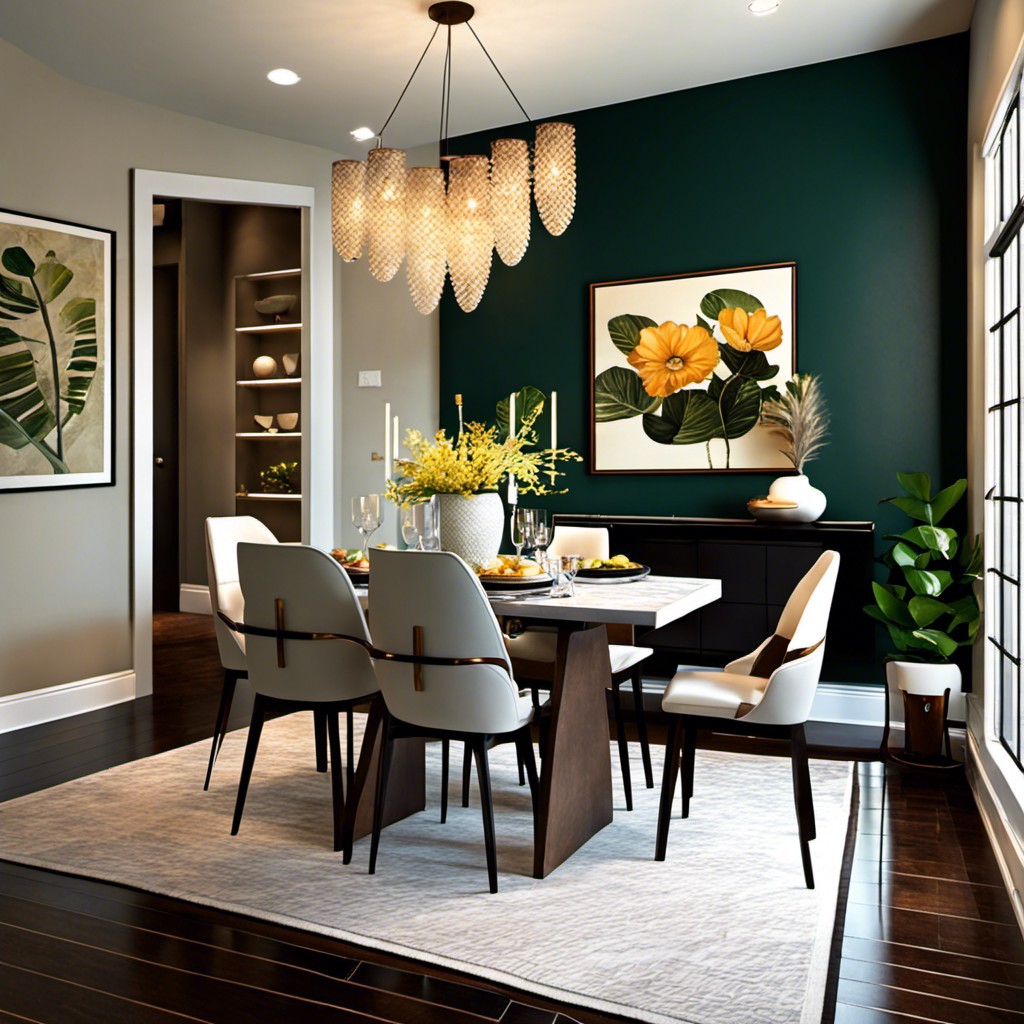
Stepping beyond traditional forms of lighting can do wonders in enhancing the overall dining room decor. Take wall sconces, for example. They not only cater to your illumination needs but also add unique aesthetic appeal.
Experimenting with the shapes, sizes, and materials is the key. Opt for contemporary geometric designs for a modern setup, or choose a traditional candelabra style for a classic touch. Bronze, brass, steel, or glass – the choice of material can significantly impact the look and feel.
Remember, placement matters. Align them at constant intervals for a symmetric look or at different heights for an asymmetric but dynamic appeal. Consider the color and texture of the wall while selecting the sconce to create a balanced visual appeal.
Investing in dimmable options can be a game-changer, providing the flexibility to adjust ambient lighting based on the mood and occasion.
